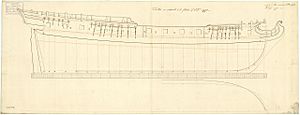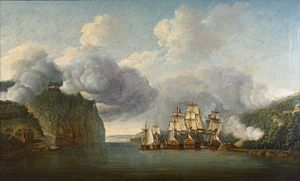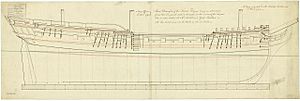HMS Tartar (1756) facts for kids

Tartar (original plan)
|
|
Quick facts for kids History |
|
|---|---|
| Name | Tartar |
| Operator | Royal Navy |
| Ordered | 12 June 1755 |
| Builder | John Randall's yard, Nelson Dock, Rotherhithe |
| Laid down | 4 July 1755 |
| Launched | 3 April 1756 |
| Completed | 2 May 1756 at Deptford Dockyard |
| Fate | Wrecked 1 April 1797 |
| General characteristics | |
| Class and type | Lowestoffe-class sixth-rate frigate |
| Tons burthen | 587 19⁄94 (bm) (4 tons more than designed) |
| Length |
|
| Beam | 33 ft 9 in (10.3 m) |
| Depth of hold | 10 ft 3 in (3.1 m) |
| Sail plan | Full-rigged ship |
| Complement | 200 officers and men |
| Armament |
|
HMS Tartar was a fast sailing ship of the Royal Navy. It had 28 guns and was known as a "sixth-rate" frigate.
Contents
A Ship's Story: HMS Tartar
Building a Fast Frigate
Tartar was designed by a famous ship designer named Sir Thomas Slade. Her design was based on an earlier ship, Lyme. The goal was to make Tartar even better at holding sailors and carrying guns.
She was first ready for duty in March 1756. Her first captain was Captain John Lockhart. Tartar quickly became known for being very fast, especially when sailing in the English Channel.
Battles and Captures during the Seven Years' War
Tartar played a big role in the Seven Years' War. This was a major global conflict that involved many European powers. During this war, Tartar captured many French ships. For example, she captured four ships in 1756 and seven more in 1757. Many of these were "privateers," which were armed ships owned by private individuals but allowed by their government to attack enemy ships.
Some of the ships Tartar captured include:
- In August 1756, she captured Le Cerf, a French privateer with 24 guns and 200 crew members.
- Later in 1756, she captured Hero, another French privateer.
- In March 1757, Tartar captured La Victoire, a privateer from Le Havre, France.
- She also captured Le Duc d'Aguillon in April 1757 and La Penelope in May 1757.
Exploring the Seas: Finding Longitude
After the war, there was a time of peace. Tartar sailed to Barbados in the Caribbean. On this journey, she carried a special clock called a timekeeper. This timekeeper was built by John Harrison. It was part of important experiments to figure out longitude at sea. Longitude is a way to measure how far east or west a ship is, which was very hard to do accurately back then.
Service in the American Revolutionary War
Tartar also served during the American Revolutionary War. This war was when the American colonies fought for their independence from Great Britain.
- On April 1, 1777, Tartar destroyed an American ship off the coast of New Jersey.
- On November 11, 1779, she captured a Spanish ship called Santa Margarita. This ship had 28 guns and was captured near Cape Finisterre.
Later Years and Final Fate
Tartar continued her service during the French Revolutionary War. This was another conflict involving France and other European powers.
- In December, 1794, a French ship captured a British cargo ship called Hannibal.
- However, just eleven days later, Tartar recaptured Hannibal near Toulon and sent her to Corsica.
In August 1793, Tartar was part of a fleet led by Lord Hood. This fleet took control of Toulon, a port city in France. Tartar helped cover the landing of 1500 soldiers who were sent to take over the forts guarding the port. Once the forts were safe, the rest of the fleet sailed into the harbor.
Sadly, Tartar was wrecked off the coast of Saint-Domingue (now Haiti) on April 1, 1797.



